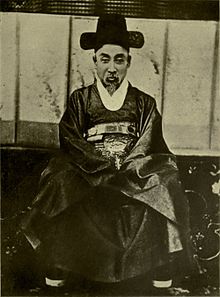| Yi Ha-eung 이하응 | |
|---|---|
 Photograph by Homer Hulbert | |
| Grand Internal Prince of Joseon | |
| Predecessor | Grand Internal Prince Jeongye |
| Successor | Title abolished |
| Regent of Joseon | |
| Regency | 21 January 1864 – 31 October 1873 with Queen Sinjeong |
| Predecessor | Cheoljong of Joseon |
| Successor | Queen Myeongseong |
| Born | 24 January 1821 Hanseong, Joseon |
| Died | 22 February 1898 (aged 77) Seongjeosibli, Korean Empire |
| Spouse | Grand Internal Princess Consort Sunmok |
| Issue | Prince Imperial Heungchin Emperor Gojong of Korea Prince Imperial Waneun (illegitimate) |
| Dynasty | House of Yi |
| Father | Yi Gu, Prince Namyeon |
| Mother | Princess Consort Min |
| Korean name | |
| Hangul | 흥선대원군 |
| Hanja | 興宣大院君 |
| Revised Romanization | Heungseon Daewongun |
| McCune–Reischauer | Hŭngsŏn Taewŏn'gum |
| Art name | |
| Hangul | 석파 |
| Hanja | 石坡 |
| Revised Romanization | Seokpa |
| McCune–Reischauer | Sŏkp'a |
| Birth name | |
| Hangul | 이하응 |
| Hanja | 李昰應 |
| Revised Romanization | Yi Ha-eung |
| McCune–Reischauer | Yi Ha-ŭng |
| Courtesy name | |
| Hangul | 시백 |
| Hanja | 時伯 |
| Revised Romanization | Sibaek |
| McCune–Reischauer | Sibaek |
Heungseon Daewongun (Korean: 흥선대원군; Hanja: 興宣大院君; 24 January 1821 – 22 February 1898) was the title of Yi Ha-eung, the regent of Joseon during the minority of Emperor Gojong in the 1860s. Until his death, he was a key political figure of late Joseon Korea. He was also called the Daewongun (lit. 'Grand Internal Prince', sometimes translated as "regent"),[a] Guktaegong,[b] or later Internal King Heonui,[c] and also known to contemporary western diplomats as Prince Gung.[citation needed]
Daewongun literally translates as "prince of the great court", a title customarily granted to the father of the reigning monarch when that father did not reign himself (usually because his son had been adopted as heir of a relative who did reign).[1] While there had been three other Daewonguns during the Joseon dynasty, there was no one as dominant as Yi Ha-Eung in the history of the Joseon dynasty that the term Daewongun usually refers specifically to him.
Joseon was going through changes in many aspects during this period, but was for the most part unable to keep up with the rapidly changing situation the country found itself in. Yi Ha-eung, had to solve both the looming threat posed by Western nations, which were continuously encroaching upon the sovereignty of Eastern states, while at the same time attempt to rebuild a country ravaged by poverty and internal power struggles.[2] He is remembered both for the wide-ranging reforms he attempted during his regency, as well as for what was described by historian Hilary Conroy as "vigorous enforcement of the seclusion policy, persecution of Christians, and the killing or driving off of foreigners who landed on Korean soil".[3]
Cite error: There are <ref group=lower-alpha> tags or {{efn}} templates on this page, but the references will not show without a {{reflist|group=lower-alpha}} template or {{notelist}} template (see the help page).
- ^ K. Kale Yu (2019). Understanding Korean Christianity: Grassroot Perspectives on Causes, Culture, and Responses. Wipf and Stock. p. 84. ISBN 978-1-5326-9253-6.
- ^ Kim, Jung-mi. "흥선대원군". terms.naver.com (in Korean). Retrieved 11 December 2023.
- ^ Conroy, Hilary (1960). The Japanese Seizure of Korea, 1868–1910: A Study of Realism and Idealism in International Relations. Philadelphia: University of Pennsylvania Press.